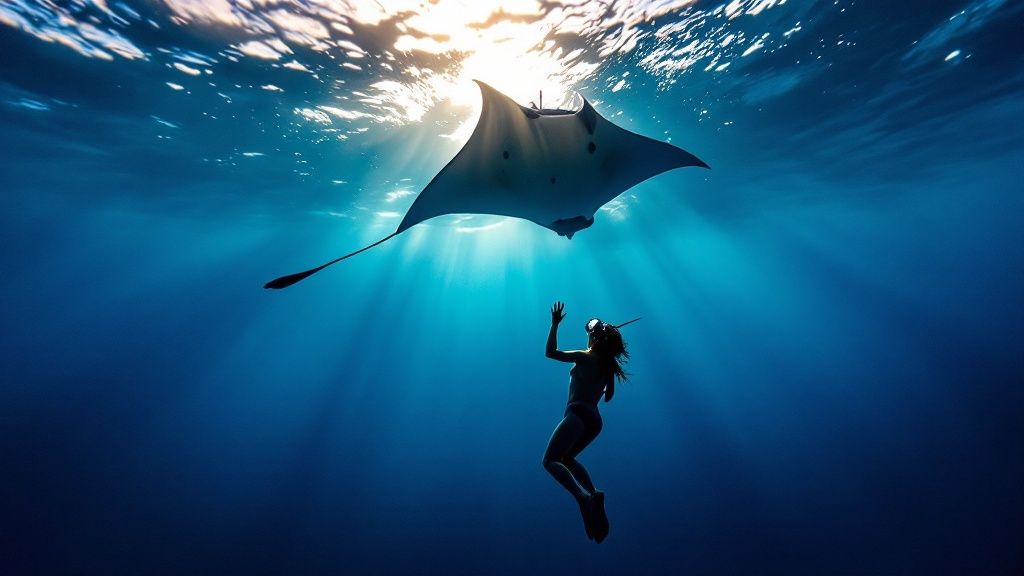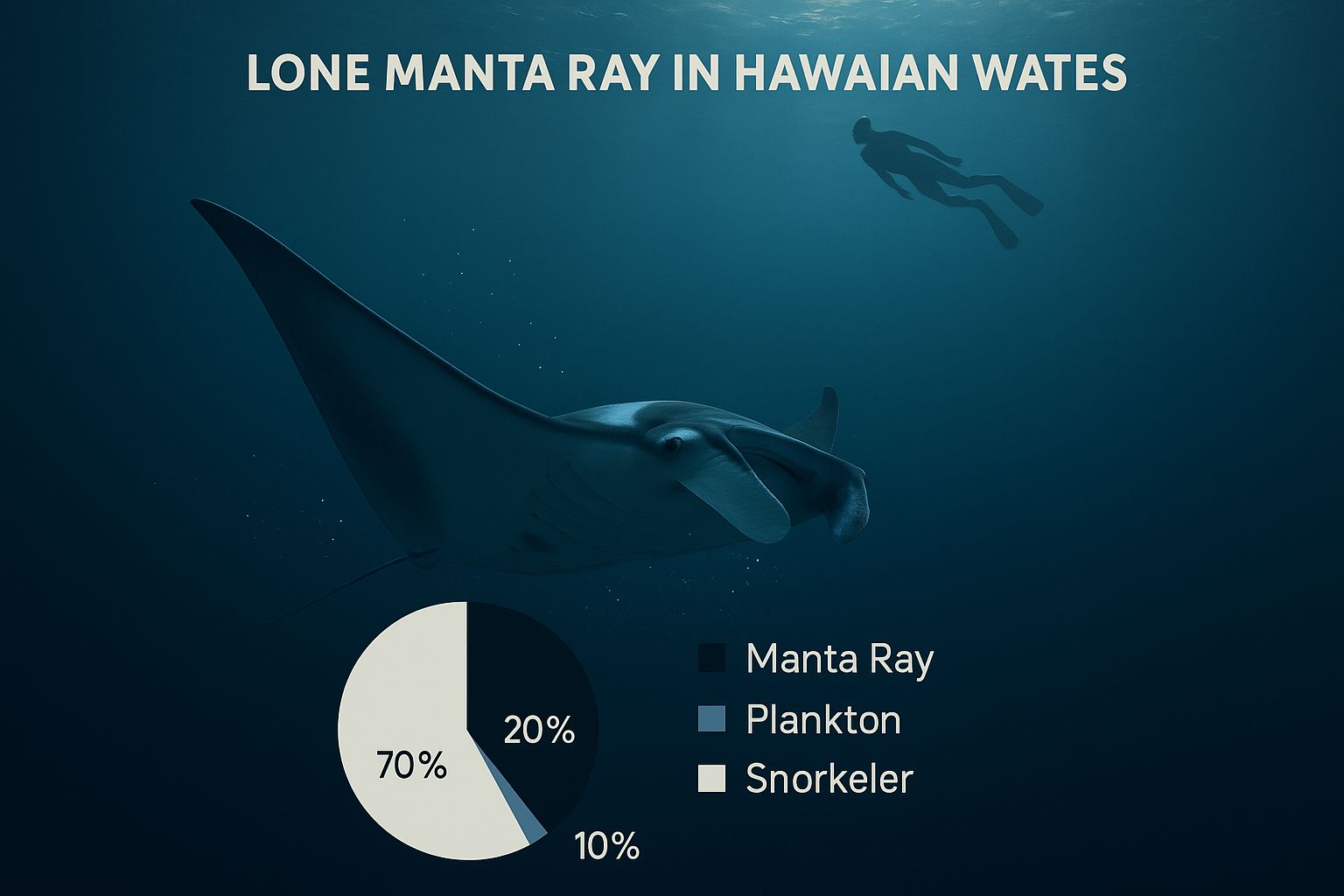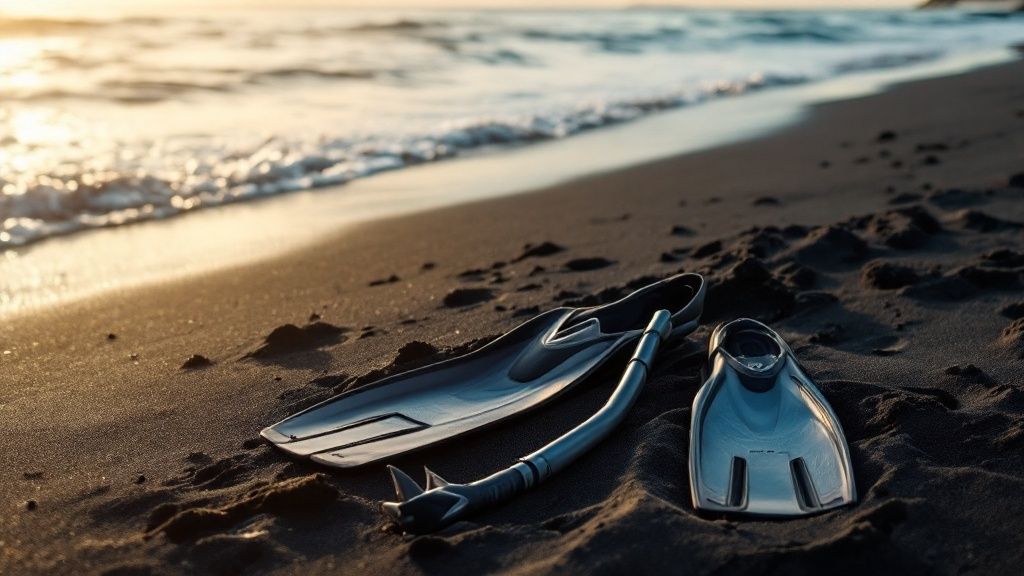Manta Ray Snorkel Kona – Unforgettable Underwater Adventure
- Byron
- May 21
- 11 min read
The Magic of Manta Ray Encounters in Kona Waters

Floating in the dark waters off Kona, waiting for the arrival of manta rays, is a truly captivating experience. Unlike other wildlife encounters, the darkness heightens your senses, making the mantas' appearance even more dramatic. This amplified sensory experience is a key part of the magic.
Why Kona is a Manta Ray Hotspot
The waters around Kona offer an ideal environment for manta rays. The unique underwater landscape and nutrient-rich currents create perfect feeding grounds, attracting large numbers of these graceful creatures. This abundance of marine life makes Kona a prime location for manta ray adventures.
Manta Village and Manta Heaven are two particularly well-known spots for consistent manta ray activity. Numerous tours are available for snorkeling with the rays, including options from companies like Manta Ray Snorkel Kona Hawaii.
The warm, clear waters also provide excellent visibility, even at night. This clarity, combined with the dark backdrop, creates an unforgettable viewing experience. It's not just about seeing the manta rays; it's about connecting with them in their natural habitat. To learn more, check out this article about the manta ray snorkel Kona experience.
The Nighttime Element: Amplifying the Experience
The nighttime setting of a manta ray encounter adds a layer of mystique not found in daytime snorkeling. The darkness enhances the bioluminescent plankton the manta rays feed on, creating a mesmerizing display of light and movement.
This otherworldly spectacle is what truly distinguishes manta ray night snorkeling. It's like watching an underwater ballet illuminated by stars. The popularity of snorkeling with manta rays in Kona has grown significantly, attracting thousands of visitors annually, thanks in large part to this unique nighttime experience. Detailed statistics can be found here.
This experience fosters a powerful emotional connection, often described as transformative. It's a reminder of the natural world's beauty and the importance of protecting these gentle giants and their environment. For those interested in learning more, here’s a helpful guide: How to master your manta ray night snorkel.
Prime Locations: Where Manta Magic Happens in Kona
Kona, Hawaii, a true haven for manta ray enthusiasts, offers several unique snorkeling spots. Two locations, in particular, consistently draw visitors eager to experience the magic of these gentle giants: Manta Village and Manta Heaven. These names aren't just marketing gimmicks; they reflect years of observing and understanding manta ray behavior. Choosing the right spot depends on factors like your comfort level in the water and the kind of encounter you're looking for.
Manta Village: A Shallow-Water Spectacle
Manta Village, nestled in Keauhou Bay, is renowned for its shallow, sandy bottom. This unique environment fosters plankton growth, the primary food source for manta rays, attracting them in impressive numbers. The shallow depth makes this location ideal for beginners and those who prefer calmer waters. Imagine floating peacefully as these graceful creatures glide beneath you, illuminated by the soft glow of dive lights. It's a truly captivating experience.
Manta Heaven: Deeper Waters, More Mantas
Manta Heaven, located a bit further offshore, offers a different perspective. The deeper waters here often attract larger groups of manta rays. This makes it a great choice for experienced snorkelers comfortable in deeper water and those hoping to see a larger gathering of these magnificent animals. Manta Heaven is also known for slightly stronger currents, which can add a touch of adventure to the snorkel.
To help you choose the best location for your snorkeling adventure, we've compiled a comparison table:
Comparison of Top Manta Ray Snorkeling Locations in Kona
This table compares the primary locations for manta ray snorkeling in Kona, highlighting differences in accessibility, typical manta ray numbers, and experience characteristics
Location | Average Mantas | Water Depth | Best Time | Access Method | Experience Level |
|---|---|---|---|---|---|
Manta Village | 5-10 | 10-20 ft | Sunset-Night | Boat | Beginner-Intermediate |
Manta Heaven | 10-20+ | 30-40 ft | Sunset-Night | Boat | Intermediate-Advanced |
As you can see, each location offers a unique experience. Manta Village offers a more relaxed setting for beginners, while Manta Heaven caters to those seeking a potentially larger manta ray gathering in slightly deeper waters.
Choosing the Right Spot: Factors to Consider
Several factors might influence your decision. If you're a novice snorkeler or prefer calmer conditions, Manta Village offers a more relaxed experience. For more experienced snorkelers comfortable with deeper water and the chance to see a larger number of mantas, Manta Heaven might be the better choice. Kona manta ray snorkeling tours are readily available, and this link offers more information about the Kona location. Kona, Hawaii, boasts a remarkably high success rate for manta ray sightings. Roughly 80,000 people participate in snorkeling tours annually, with a sighting success rate between 80% and 90% year-round, thanks to the nutrient-rich waters. Find more detailed statistics here. This impressive success rate, combined with the distinctive characteristics of each site, makes Kona a world-class destination for manta ray encounters. Understanding these nuances will help you choose the perfect spot to witness the manta magic firsthand.
Timing Your Encounter: When Mantas Show Their Best Side
Planning a manta ray snorkel Kona adventure is more than just booking a tour; it's about understanding when these magnificent creatures are most active. While you can see manta rays year-round in Kona, certain times offer a better chance of an unforgettable encounter. Factors like moon phases, plankton blooms, and even crowd sizes can influence your experience. Careful planning can greatly increase your chances of a truly magical encounter. You might be interested in: How to master your manta ray experience.
Decoding the Manta Ray Calendar
Many believe manta rays follow strict seasonal patterns, but the truth is more nuanced. Their feeding behavior, which dictates where and when they gather, revolves around plankton. Plankton, in turn, is influenced by factors like water temperature, currents, and the lunar cycle.
For example, during a full moon, increased light attracts plankton to the surface, creating a feast for the manta rays. Consequently, manta ray activity is often heightened around the full moon. This doesn't mean other times are unsuitable for snorkeling; it simply highlights periods of potentially higher manta ray concentrations.

This infographic depicts a lone manta ray gracefully gliding through the dark Hawaiian waters, its wings outstretched amidst a flurry of plankton-lit bubbles, as a distant snorkeler observes this captivating scene.
The image beautifully captures the essence of a manta ray encounter, highlighting plankton's crucial role in attracting these gentle giants. The interplay of light and shadow, combined with the snorkeler’s presence, emphasizes this experience's unique and awe-inspiring nature.
Understanding Plankton and Lunar Cycles
The relationship between plankton blooms, moon phases, and manta ray feeding is a delicate balance. While a full moon often brings increased manta ray activity, it also attracts more snorkelers, potentially creating a more crowded viewing experience. Water clarity can also fluctuate throughout the year. Let's take a closer look at the seasonal variations in manta ray sightings in Kona. The following table provides a general overview and may not reflect real-time conditions.
To help you better understand the seasonal variations in manta ray sightings, we've compiled the following table: "Seasonal Manta Ray Sighting Statistics in Kona". This table presents seasonal sighting data, including the average number of mantas spotted, visibility conditions, and success rates throughout the year. This data is for illustrative purposes only and doesn't represent actual collected statistics.
Season | Average Mantas Per Tour | Sighting Success Rate | Water Visibility | Ocean Conditions | Notes |
|---|---|---|---|---|---|
Spring | 8-12 | 95% | 50-75ft | Generally Calm | Peak season, plankton blooms frequent |
Summer | 6-10 | 90% | 60-80ft | Calm to Moderate | Warm water, good visibility |
Fall | 4-8 | 85% | 40-60ft | Moderate | Transition season, variable conditions |
Winter | 3-6 | 80% | 30-50ft | Can be Rough | Fewer mantas, potential for rough seas |
As you can see, each season offers a unique set of conditions. While spring boasts the highest average number of manta rays per tour, summer offers excellent visibility. Fall and winter offer a quieter experience with fewer crowds, although the number of manta rays sighted might be slightly lower.
Finding the Perfect Balance
Detailed sighting statistics for manta rays in Kona have been tracked annually since 2009, offering invaluable insights. These statistics provide valuable insights into the behavior and population dynamics of manta rays. For example, the data from 2009 to 2014 includes information on individual manta rays, their physiological condition, and specific locations. This data has helped researchers understand how manta rays travel within their home range and predict when higher numbers are likely to be seen. Find more detailed statistics here.
Ultimately, the best time for a manta ray snorkel Kona experience depends on your priorities. If you prefer a less crowded encounter, consider booking a tour during a quarter moon or even a new moon. While manta ray numbers might be slightly lower, the enhanced viewing experience can be incredibly rewarding. If seeing as many mantas as possible is your goal, plan your trip around a full moon.
Selecting Your Perfect Manta Ray Experience
Choosing the right manta ray snorkel Kona tour can make all the difference in your overall experience. With so many operators to choose from, it's important to do your research and understand what truly sets a memorable encounter apart. Asking the right questions and knowing your priorities are key.
Decoding the Budget vs. Premium Debate
One of the first things you'll need to decide is whether you prefer a budget-friendly group tour or a premium, private charter. Group tours are appealing because of their lower price point, often falling between $90 and $150. However, this lower cost can mean larger groups, potentially less individual attention from the guides, and a more crowded viewing experience.
Private charters, on the other hand, offer a more exclusive and personalized adventure. With smaller groups, usually between 2 and 6 people, you’ll have more opportunities to interact with your guide and enjoy a more intimate experience with the manta rays. This personalized attention comes at a higher cost, typically upwards of $300, so it's important to consider your budget.
Key Questions to Uncover the Best Experience
Regardless of your budget, there are certain questions you should ask to help you identify tour operators dedicated to quality. Start by asking about crew-to-guest ratios. A lower ratio generally translates to more personalized attention and improved safety. Next, inquire about the quality of the provided equipment, such as wetsuits, snorkels, and flotation devices. Comfortable, well-maintained gear can significantly improve your time in the water. For more tips and information, check out our guide on manta ray snorkel Kona top tips and best spots.
Evaluating Vessels and Conservation Credentials
The type of vessel also matters. Larger catamarans provide stability and comfort, which can be helpful for those prone to seasickness. Smaller boats, however, offer greater maneuverability, allowing captains to quickly reposition if the manta rays move. Finally, don't forget to ask about the operator's conservation credentials. Choosing a company committed to sustainable practices ensures your trip supports responsible manta ray tourism, contributing to the long-term health of these incredible animals and their habitat.
Insider Tips for Identifying Exceptional Operators
Here’s a quick checklist to help you find the best tour operator for your needs:
Read online reviews: Reviews from previous participants can offer valuable insights.
Look for certifications: Certifications, such as PADI 5-Star, or affiliations with marine research organizations demonstrate a commitment to professionalism and credibility.
Ask about guide experience: Guides with extensive experience and knowledge of manta ray behavior can enhance both the safety and educational aspects of your tour.
Inquire about emergency procedures: Any reputable operator will have clear safety protocols in place.
By considering these factors and asking the right questions, you can choose a manta ray snorkel Kona tour that perfectly suits your needs and ensures a magical, unforgettable experience. This careful selection process empowers you to maximize your enjoyment and support responsible manta ray tourism, directly contributing to the well-being of these gentle giants.
Preparing for Magic: Get the Most From Your Manta Night

Turning your manta ray night snorkel in Kona from simply good to truly extraordinary depends on preparation. This means not just being physically ready, but also understanding how to optimize your gear, handle any pre-swim jitters, and cultivate the right mindset for a magical encounter.
Physical and Mental Preparation: Ensuring a Smooth Experience
You don't have to be Michael Phelps to enjoy a manta ray night snorkel in Kona, but a reasonable level of swimming ability is important. If you haven't been in the water lately, practicing in a pool or calm shallows beforehand can make a big difference in your confidence. This pre-trip practice lets you get reacquainted with your snorkel and mask, minimizing any potential discomfort during the actual experience. Improving your overall fitness will also help you handle any currents and fully enjoy the adventure without getting tired.
For some, the open ocean at night can be a little daunting. But simple mental preparation can ease these worries. Visualizing the experience, focusing on the beauty of the manta rays, and practicing deep breathing exercises can help calm nerves and build excitement for the upcoming encounter. You might also find this helpful: How to master your manta ray night snorkel.
Gear Optimization: Enhancing Comfort and Visibility
The right gear plays a key role in maximizing your comfort and enjoyment during your manta ray snorkel. A wetsuit, even in Hawaii's relatively warm waters, is essential for night snorkeling. As the sun goes down, the water temperature can drop, and a 3mm wetsuit provides optimal warmth without restricting movement. Remember, maintaining body temperature is crucial for a comfortable, long experience.
Anti-fog solution for your mask is also a must. Apply it thoroughly before entering the water, and consider a spit-shine as a backup to ensure clear visibility. A pool noodle can provide added buoyancy and conserve energy, especially for less confident swimmers.
Practical Tips: Mastering In-Water Techniques
Beyond gear, a few practical techniques can further improve your experience. Practicing water entry techniques in a pool beforehand can minimize any initial discomfort when entering the ocean. This helps refine your entry, reducing splash and disorientation. Focus on slow, deep breaths through your snorkel, maintaining a steady rhythm to avoid hyperventilation and conserve energy.
If you tend to get seasick, consider taking motion sickness medication or using acupressure wristbands before your tour. These precautions can prevent discomfort and allow you to fully enjoy the magical experience. By addressing these practical aspects and focusing on preparation, you'll be ready to immerse yourself in the wonder of a manta ray night snorkel in Kona.
Swimming With Giants: The Ethics of Manta Encounters
Manta ray snorkel tours in Kona offer an incredible chance to see these gentle giants up close. However, it's important to remember that we affect their world. This section explores the vital link between responsible tourism and successful manta ray conservation. We'll learn how thoughtful participation in these tours can actively support research and protection, drawing on insights from marine biologists and conservation leaders.
Kona: A Global Model for Sustainable Wildlife Interaction
Kona has become a world-renowned example of how sustainable wildlife tourism can flourish. The local manta ray tourism model shows how the economic benefits of responsible tourism can directly protect these amazing creatures. For example, the revenue from manta ray tours helps fund research and conservation programs. It also creates jobs for local communities, fostering a vested interest in protecting the manta rays and their habitat. By choosing a responsible manta ray tour, you directly contribute to their long-term survival. Curious to learn more about the experience? Check out this helpful guide: How to master the manta ray night snorkel.
The Evolution of Viewing Practices: Minimizing Impact
Manta ray viewing practices in Kona have changed significantly over time. Early interactions were less organized and could stress the manta rays. But through ongoing research and teamwork between tour operators, scientists, and conservationists, best practices have been developed and implemented. These guidelines focus on minimizing disruptions to the manta rays' natural behavior. For instance, tour operators now follow strict rules about boat positioning, lighting, and snorkeler interaction.
Citizen Science: Empowering Tourists to Contribute to Research
Citizen scientists have significantly helped advance manta ray research in Kona. Tour participants, led by trained professionals, can provide valuable data about manta ray behavior, population sizes, and individual identification. Many operators encourage guests to take photos of manta rays. The unique spot patterns on their undersides, much like fingerprints, allow researchers to track individuals over time. This collaborative approach not only improves our understanding of manta rays but also empowers tourists to play an active role in conservation.
Conscious Visitors: Ensuring a Sustainable Future for Manta Encounters
As visitors, we play a key role in ensuring the future of these extraordinary encounters. By selecting operators committed to sustainable practices, we support responsible tourism and help protect manta rays for future generations. Here's how you can contribute:
Choose responsible operators: Look for certifications or partnerships with marine conservation organizations.
Respect wildlife guidelines: Keep a safe distance from the manta rays and don't touch them.
Participate in citizen science initiatives: Help with research by photographing manta rays and sharing your observations.
Educate yourself: Learn about manta ray biology and why their conservation is so important.
Spread the word: Share your positive experiences with responsible manta ray tourism and encourage others to choose ethical operators.
By following these principles, we can ensure that manta ray snorkel experiences in Kona remain a source of wonder and inspiration for years to come. Book your unforgettable and ethical manta ray night snorkel tour today! Manta Ray Night Snorkel Kona Hawaii Tours provides a variety of options to choose from, guaranteeing a magical experience for everyone.
Comments